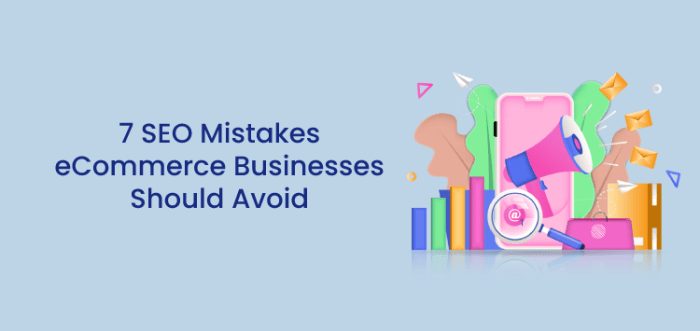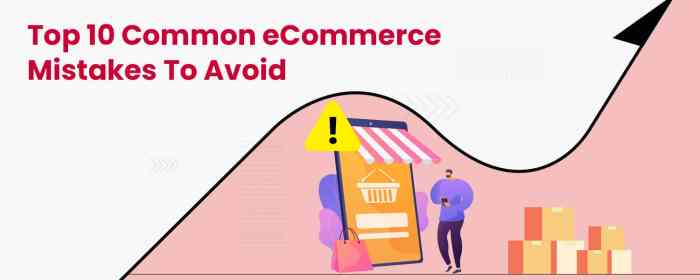Avoid These Common SEO Mistakes in E-Commerce Business
Embark on a journey through the realm of mistakes in the e-commerce world. Discover how steering clear of these pitfalls can pave the way for online success, all presented in a captivating manner that will keep you hooked.
Delve into the details of each mistake and why rectifying them is crucial for any e-commerce venture looking to thrive in the digital landscape.
Common Mistakes E-Commerce Businesses Should Avoid
When it comes to for e-commerce websites, avoiding common mistakes is crucial for achieving online success. These mistakes can negatively impact search rankings and hinder the visibility of your online store to potential customers. Let's explore some of the most common mistakes e-commerce businesses should steer clear of:
1. Ignoring Mobile Optimization
- Not having a mobile-responsive website design can lead to a poor user experience on mobile devices.
- Google prioritizes mobile-friendly websites in search results, so neglecting mobile optimization can hurt your rankings.
2. Neglecting Product Descriptions and Metadata
- Leaving product descriptions empty or duplicate can result in low-quality content, affecting your site's search visibility.
- Missing or poorly optimized metadata, such as title tags and meta descriptions, can hinder search engines from understanding your products and services.
3. Overlooking Image Optimization
- Not optimizing image alt text and filenames can miss out on valuable opportunities for ranking in image search results.
- Large image file sizes can slow down your website loading speed, negatively impacting user experience and performance.
4. Neglecting Local Strategies
- Forgetting to optimize for local s and create Google My Business listings can limit your visibility in local searches.
- Ignoring local reviews and citations can result in missed opportunities to build credibility and attract local customers.
Lack of Mobile Optimization
In today's digital age, having a mobile-optimized website is crucial for e-commerce businesses to succeed. With the increasing number of users shopping online through their mobile devices, neglecting mobile optimization can lead to a significant loss in potential customers and revenue.
The Importance of Mobile Optimization
Mobile optimization ensures that your website is user-friendly and accessible on smartphones and tablets, providing a seamless shopping experience for mobile users. This is essential as more people are using mobile devices to browse and make purchases online.
- Responsive Design: Implement a responsive design that adapts to different screen sizes, ensuring your website looks and functions well on any device.
- Fast Loading Speed: Optimize images, minimize code, and leverage browser caching to improve loading speed on mobile devices.
- Mobile-Friendly Content: Create concise and engaging content that is easy to read on smaller screens, keeping the user experience in mind.
Ignoring On-Page Elements

Ignoring on-page elements is a common mistake that e-commerce businesses make, hindering their search engine visibility and overall online success. Optimal use of on-page elements is crucial for improving search engine rankings and attracting more organic traffic to your website.
Key On-Page Elements
- Meta Tags: Ensure that each page has unique and relevant meta titles and descriptions that accurately reflect the content.
- Optimization: Conduct research and strategically place relevant s throughout your website content, including headings, URLs, and image alt text.
- Quality Content: Create high-quality, engaging content that provides value to your audience and encourages them to stay on your site longer.
- Internal Linking: Link relevant pages within your website to improve navigation and distribute link equity throughout your site.
- Image Optimization: Optimize images by using descriptive file names and alt text to improve accessibility and enhance .
Neglecting Product Descriptions and Meta Tags

Product descriptions and meta tags play a crucial role in the strategy of e-commerce businesses. Neglecting these elements can result in lower search engine rankings and decreased visibility to potential customers. Let's explore the impact of well-crafted product descriptions and meta tags on and how businesses can optimize them effectively.
Impact of Well-Crafted Product Descriptions and Meta Tags
Product descriptions provide valuable information about the products, helping search engines understand the content of the page. Well-written descriptions can improve the overall user experience and increase the chances of conversion. On the other hand, meta tags, including meta titles and meta descriptions, are displayed in search engine results and can significantly impact click-through rates.
- Product descriptions should be unique, detailed, and engaging to capture the attention of both search engines and potential customers.
- Meta titles should be concise, containing relevant s to improve search engine visibility.
- Meta descriptions should be compelling, providing a brief overview of the product to entice users to click on the link.
Tips for Creating Compelling Product Descriptions
Creating compelling product descriptions requires a good understanding of the target audience and the product itself. Here are some tips to help e-commerce businesses craft effective product descriptions:
- Highlight the unique selling points of the product to differentiate it from competitors.
- Use descriptive language to create a vivid picture of the product in the customer's mind.
- Incorporate relevant s naturally to improve search engine optimization.
- Provide accurate and detailed information about the product's features, benefits, and specifications.
Guidelines for Optimizing Meta Tags
Optimizing meta tags is essential for improving search engine rankings and increasing click-through rates. Follow these guidelines to optimize meta tags effectively:
- Include primary s in meta titles and descriptions to enhance search engine visibility.
- Avoid duplicate meta tags across different product pages to prevent confusion for search engines.
- Keep meta titles under 60 characters and meta descriptions under 160 characters for optimal display in search results.
- Create unique and compelling meta tags for each product page to attract potential customers.
Slow Page Load Speed
Slow page load speed can significantly impact the performance of e-commerce websites. Search engines like Google consider page speed as a ranking factor, meaning that slow-loading pages may be penalized in search results. Additionally, slow page load speed can lead to higher bounce rates, lower conversion rates, and poor user experience, all of which can negatively affect a website's efforts.
Tools to Test and Improve Page Load Speed
- Google PageSpeed Insights: This tool analyzes the content of a web page and provides suggestions to improve its speed.
- GTmetrix: GTmetrix offers insights on how well a site loads and provides recommendations for optimization.
- WebPageTest: WebPageTest allows users to test a website's performance from multiple locations and different browsers.
Strategies for Optimizing Images, Scripts, and Content
- Optimize Images: Compress images without compromising quality, use the correct file format (JPEG, PNG, etc.), and specify image dimensions.
- Minimize Scripts: Reduce unnecessary scripts, combine and minify CSS and JavaScript files, and utilize browser caching.
- Content Optimization: Prioritize above-the-fold content, defer non-critical JavaScript, and use lazy loading for images and videos.
Duplicate Content Issues

Duplicate content can have a detrimental impact on the performance of e-commerce websites. Search engines like Google may penalize sites with duplicate content by lowering their rankings or omitting them from search results altogether. It can confuse search engines about which version of the content to index, leading to a loss of visibility and traffic.
Identifying Duplicate Content
- Use tools like Copyscape or Siteliner to scan your website for duplicate content.
- Check for URL parameters generating multiple versions of the same page.
- Look for syndicated content that appears on multiple websites.
Resolving Duplicate Content Issues
- Set up 301 redirects to canonical URLs to consolidate duplicate content.
- Use rel="canonical" tags to specify the preferred URL for indexing.
- Implement parameter handling in Google Search Console to specify which URL parameters to ignore.
Best Practices for Unique Content
- Create original product descriptions and avoid copying manufacturer-provided content.
- Add value to your content by providing in-depth information, user reviews, and unique perspectives.
- Regularly update and refresh your content to keep it relevant and engaging for users.
Wrap-Up
As we wrap up our exploration of common blunders in e-commerce, remember that avoiding these missteps is key to unlocking the full potential of your online business. Stay informed, stay ahead, and watch your digital presence soar.
FAQ Resource
What are some common mistakes e-commerce businesses make?
Some common mistakes include neglecting mobile optimization, ignoring on-page elements, neglecting product descriptions and meta tags, slow page load speed, and duplicate content issues.
How does mobile optimization impact e-commerce websites?
Mobile optimization is crucial as the number of mobile users in online shopping is increasing. E-commerce businesses need to ensure their websites are optimized for a seamless mobile experience.
Why are product descriptions and meta tags important for ?
Well-crafted product descriptions and optimized meta tags improve by providing search engines with relevant information about your products, increasing visibility and click-through rates.
What strategies can e-commerce websites use to improve page load speed?
Optimizing images, scripts, and content, using tools to test and enhance load speed, and ensuring efficient website performance are key strategies to improve page load speed.
How can e-commerce websites create unique content to avoid duplicate content issues?
By focusing on producing valuable and original content, e-commerce websites can steer clear of duplicate content issues. Implementing best practices for content creation is essential.




